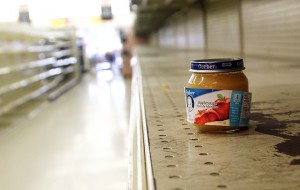
Travis Taylor | Lariat Photo Editor
Reporter
Neighborhoods without a source of healthy food deserve a second look.
That’s the thinking behind a research project Dr. Andy Hogue, director of civic education and community service program, is heading up with his African-American politics class and the Texas Hunger Initiative.
In August, the city of Waco bid adieu to two HEB grocery stores tucked in neighborhoods on either side of Interstate 35.
The HEB locations on Speight Avenue and on Dutton Avenue served a series of low-income neighborhoods in Waco. The Speight Avenue location also served college students.
Although a larger grocery store has opened its doors at the intersection of Interstate 35 and South Valley Mills Drive, the HEB closures have many wondering about the neighborhood potentially experiencing food desert conditions.
Hogue said a food desert is a place where people’s access to fresh, whole produce — fruits and vegetables — is extremely limited.
“We’re working with the Texas Hunger Initiative to figure out what we can do,” Hogue said. “How can we minimize the impact of losing a primary source of fresh or healthy food?”
According to the U.S. Department of Agriculture, any area where 33 percent of the population or 500 individuals must travel more than one mile to the nearest grocery store or super market is a “low-access community.” That means individuals have significantly less access to healthy, whole foods.
“One of the things research shows us about food deserts is that these are disproportionately located in neighborhoods and parts of town that are populated primarily by minorities,” Hogue said. “And there’s a very close connection between things like access to food and issues of hunger.”
Before offering solutions to address food problems, he said the research will provide a fuller understanding of the community’s current access to food.
The study looks at factors inhibiting people’s access to healthy, whole food. Their findings about produce availability, even sidewalk conditions in the region spanning from Clay Street to Gurley Avenue, and 18th Street to Eighth Street, will be applied to a topographical map.
The study, which his students are carrying out in small teams, examines the region by blocks.
Lubbock senior Shelley Gregory, a member in one of Hogue’s groups, said part of the study includes students keeping logs of “food sources,” — neighborhood restaurants, gas stations, grocery and convenience stores — recording specific GPS coordinates for mapping.
Last week, she and two others started their portion of the research project. They talked to shopkeepers at the sources they identified.
Their questions concerned whether or not fruits and vegetables were stocked on their shelves, and if food stamps were accepted.
For every source of food they note, the group wants to know what’s available and to whom.
They logged a visit to Cruz’s Drive Inn, a small, family-owned convenience store at 11th Street and Cleveland Avenue.
Anita Cruz and her daughter Diana Hernandez run the store across the street from the Kate Ross government housing leasing office.
She said mostly folks using food stamps come to the store shopping for fruits and vegetables. But, since Cruz’s Drive Inn doesn’t accept food stamps, it’s not cost effective to stock produce.
“We’re considered a convenience store,” Hernandez said.
The study group made a note of the store’s lack of vegetables. It means the store, as far as the group’s research is concerned, is not a reliable source of fresh produce.
While looking for other food sources on 11th Street, the group stopped to make note of sidewalks in poor condition.
Gregory said sidewalks to and from food sources are important to pay attention to. Cracked, overgrown sidewalks are useless to someone pushing a stroller or someone in a wheel chair. She said sidewalks represent how accessible food is to the community that uses them.
On Aug. 19, Waco Transit changed its route No. 9 to provide access to the new HEB store location at 1821 South Valley Mills Dr.
Hogue said this research project between the university and the Texas Hunger Initiative is scheduled to be completed by the end of October.
The data will be used to determine what problems, if any, affect people living in the neighborhoods nearest the former grocery stores.






